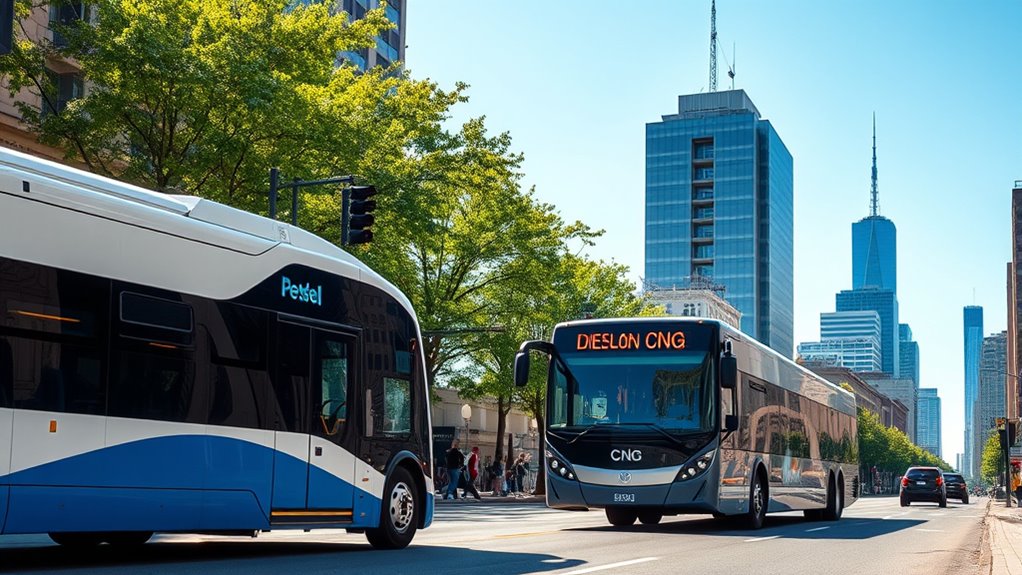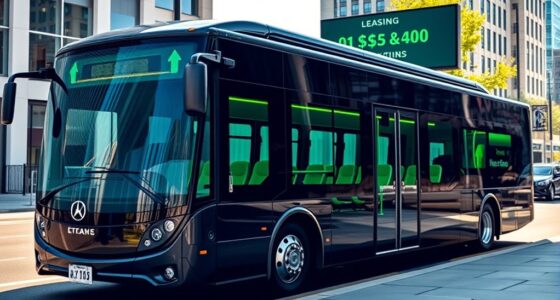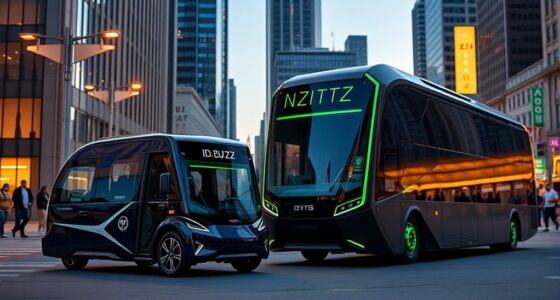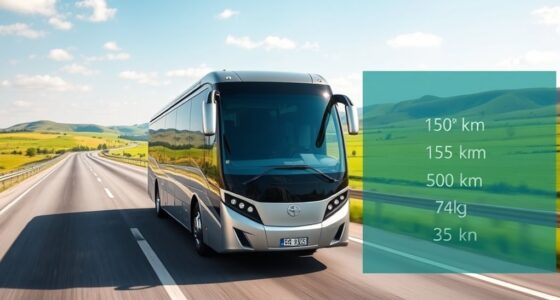Electric buses considerably cut emissions compared to clean diesel and CNG vehicles, producing zero tailpipe pollutants and lowering greenhouse gases. While clean diesel and CNG reduce some pollution, electric options offer greater health benefits and cleaner air, especially when powered by renewable energy. When considering economics, electric buses may have higher upfront costs but save money long-term through lower fuel and maintenance expenses. To see how these benefits balance out and impact your community, keep exploring the details.
Key Takeaways
- Electric buses produce zero tailpipe emissions, significantly reducing urban air pollution compared to clean diesel and CNG.
- Over their lifecycle, electric buses generally have a lower carbon footprint, especially when powered by renewable energy sources.
- Although electric buses require higher upfront investment, lower operating and maintenance costs can improve economic viability over time.
- Clean diesel and CNG emit fewer pollutants than traditional diesel but still contribute to air pollution and greenhouse gases.
- The cost-effectiveness of electric buses depends on charging infrastructure, energy prices, and advancements in battery technology.

Are electric buses truly the future of sustainable transportation? That’s a question many cities and transit authorities are asking as they evaluate options to reduce emissions and cut costs. At the heart of this shift is advancing battery technology, which plays a pivotal role in making electric buses a viable alternative. Modern batteries are becoming more efficient, with higher energy density and longer lifespans, meaning buses can travel further on a single charge. This progress alleviates range anxiety and makes electric buses more practical for daily routes. But even as battery technology improves, the success of electric buses hinges on robust charging infrastructure. Without enough charging stations strategically placed along routes, buses risk downtime, undercutting their operational advantages. Developing a thorough charging network takes investment, planning, and coordination with transit schedules, but once in place, it guarantees that buses can recharge quickly and reliably, keeping service seamless.
Compared to clean diesel and CNG (compressed natural gas), electric buses offer significant reductions in emissions. They produce zero tailpipe emissions, which means no harmful nitrogen oxides or particulate matter, directly improving air quality in urban areas. While clean diesel and CNG vehicles emit fewer pollutants than traditional diesel engines, they still release greenhouse gases and contribute to air pollution. Electric buses, powered by renewable energy sources, can dramatically cut carbon footprints. However, the overall environmental benefit depends on the electricity grid’s makeup; if the grid relies heavily on fossil fuels, the emissions savings may be less pronounced but still meaningful. Over their lifecycle, electric buses tend to be more environmentally friendly, especially as renewable energy adoption increases. Additionally, the integration of holistic health and wellness approaches into transit planning can further enhance community well-being.
Frequently Asked Questions
How Do Battery Recycling Impacts Affect Electric Bus Sustainability?
Battery recycling benefits enhance electric bus sustainability by reducing waste and conserving resources. When you address battery degradation, recycling guarantees valuable materials like lithium and cobalt are recovered and reused, minimizing environmental impact. This process helps extend the lifecycle of batteries and decreases reliance on mining new materials. Overall, recycling benefits support a more sustainable, eco-friendly approach, making electric buses a greener transportation option and strengthening their long-term viability.
What Are the Long-Term Maintenance Costs for Electric Versus Diesel Buses?
You’ll find that maintenance costs for electric buses are generally lower over the long run, thanks to fewer moving parts and less engine wear, while diesel buses require regular servicing, repairs, and oil changes. Battery lifespan plays a key role—electric buses may need battery replacements eventually, but these costs are often offset by savings on fuel and repairs. Ultimately, investing in electric buses can lead to more predictable, manageable long-term expenses.
How Does Grid Energy Source Influence Electric Bus Emissions?
Your electric bus emissions depend heavily on the grid energy source. If the grid relies on renewable integration like wind or solar, emissions stay low, making your bus cleaner. Conversely, if the grid depends on fossil fuels, emissions increase. Achieving grid stability guarantees consistent renewable energy supply, further reducing overall emissions. So, cleaner grid energy directly translates to greener bus operations, emphasizing the importance of renewable integration for sustainable transit.
Are There Regional Incentives for Adopting Electric Buses Over CNG?
Think of regional incentives as your bus’s secret weapon. You’ll find that many areas offer subsidies or policy incentives to promote electric bus adoption over CNG. These benefits can notably reduce upfront costs, making electric buses more appealing. Regions with strong commitments to clean transportation actively support this shift, so you should explore local programs. It’s like having a helpful guide leading you toward more sustainable and cost-effective transit options.
What Are the Logistical Challenges of Electric Bus Charging Infrastructure?
You’ll face logistical challenges with electric bus charging infrastructure, mainly in planning charging station placement to make certain of coverage and efficiency. You might need to coordinate with utilities for power grid upgrades, as increased demand can strain existing infrastructure. Managing charging schedules to minimize downtime and balancing load on the grid are also critical. Proper planning ensures smooth operations and helps avoid delays or technical issues.
Conclusion
Think of electric buses as the bright dawn breaking over a cleaner horizon, where emissions fade like shadows in the morning light. They may cost more upfront, but their promise of quieter streets and healthier air is worth the journey. As you navigate the choice between clean diesel, CNG, and electric, remember you’re steering toward a future where every mile you travel helps turn the tide toward sustainability. Embrace the change—your ride to a greener tomorrow starts now.









